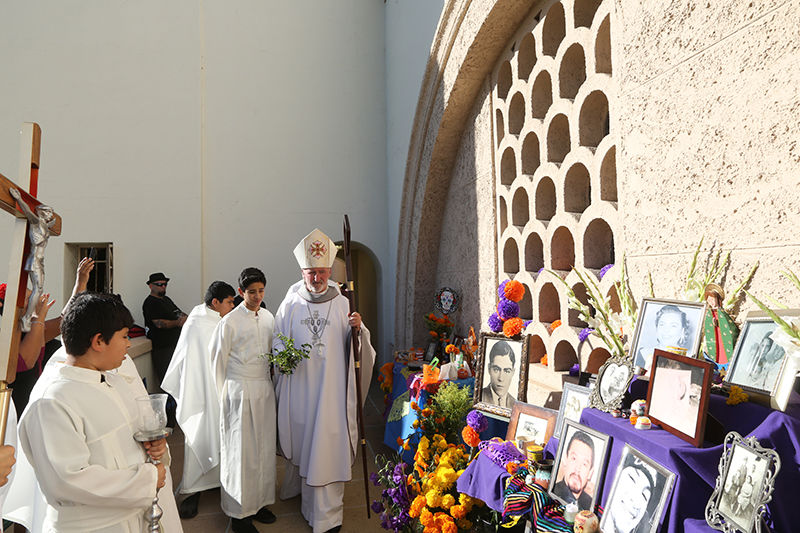What with the Solemnity of All Saints, the commemoration of All Souls’ Day and the many recent local Day of the Dead celebrations, my thoughts have turned, as they so often do, to burial plans.
Before passing away from Alzheimer’s in 2012, my saintly Protestant mother took me aside to tell me of her own interment desires. With a dreamy look in her eye, she produced a molding newspaper clipping she’d clearly been poring over for years: an ad for cut-rate caskets. “Look, here’s a nice beaverboard model,” she enthused.
She’d worked it all out. No flowers (people might have to spend money). No cortège to the gravesite, just family (people might have to waste time). No eulogy, just a simple service (people might have to think of something nice to say about her).
I understood completely her impulse to avoid both the death industry and making an unnecessary show. Personally, I would like to be laid to rest in a plain pine box beneath a live oak. That would be after, however, a high Mass. I’m with servant of God Dorothy Day, who once said, “If I am reincarnated, I hope I come back an opera singer!”
But I’m getting ahead of myself.
The Archdiocese of Los Angeles maintains 12 cemeteries, ranging from Pomona to Santa Barbara to the Mausoleum at Our Lady of Angels Cathedral.
A couple of weeks ago, I decided to visit the mother of them all: Calvary Cemetery in East L.A.
The original Calvary Cemetery was on North Broadway. What was once Cemetery Ravine is now known as Chavez Ravine. Cathedral High School stands on the old site and the cemetery chapel survives today in the parish and buildings of downtown’s St. Peter’s Italian Catholic Church.
The current 137-acre site, at the corner of Downey and Whittier boulevards, was dedicated in 1896.
Upon arriving, I drove around for a bit. The place is huge, with double depth lawn crypts, graves and niches for cremated remains of the body, an outdoor Stations of the Cross and more than 20 sections with names like Gethsemane, Immaculate Heart and Good Shepherd. The roads wind beneath eucalyptus, royal palms, magnolia. You could have a nice picnic here.
Then I thought to check in at the capacious and well-appointed administrative offices for a little general information.
“Hi!” I presented myself brightly to the two competent-looking ladies at the desk. “I write a weekly arts and culture column for ‘Angelus,’ our archdiocesan [magazine], and I thought with the Day of the Dead and all, I’d wander around and have a look-see. Do you have any brochures or …”
“You need to talk to media,” they said in unison.
“OK, but I’m not a reporter, I write more of a …”
“Any photography, filming, you need to talk to media.”
“No, no, I’m not making a film, I just want to tell the good people of L.A. about this cemetery that I, for one, after living here for 26 years, didn’t know about.”
“You need to talk to media.”
I briefly considered saying I was interested in purchasing a burial plot, which would perhaps have gotten me further, but already I knew that would be a lie.
So I gave up, took the map they kindly offered me, and made a beeline for what looked like the most inviting spot in the whole place: All Souls’ Chapel, which was dedicated on All Souls’ Day in 1902.
This sweet little stone building had rose bushes outside the door, a stained glass window of the crucifixion and a steep gabled roof topped by a white wooden cross. The door was securely locked.
I meandered among the graves, which ran the gamut from marble crypts with bronze doors to simple, flush-with-the-ground markers.
I knew from my research that old-timey Hollywood actors Lionel and Ethel Barrymore, Lou Costello, Pola Negri and Ramón Novarro are buried here. Los Angeles crime family boss Jack Dragna (1891-1956) was laid to rest at Calvary. So were oil tycoon Edward L. Doheny, California governor Henry Gage (1852-1924) and Ronald Reagan’s parents.
Leno La Bianca (1925-1969), murdered by the Charles Manson family, lies alongside Cardinal Timothy Manning (1909-1989), the third archbishop of Los Angeles. Ferdinand “Jelly Roll” Morton (1885-1941), musician, keeps company with Jose Yarba (1892-1957), a.k.a. “Mexican Joe Rivers,” boxer.
This spectrum of humanity seemed only fitting for a Catholic cemetery. Freeway traffic hummed below and Mount Wilson shimmered in the distance.
A security guard pulled up — for the second time — and cast me a suspicious look.
“Just having a look around,” I told him, gazing out over the tombs. “Just enjoying the breeze.”
For a moment, I thought longingly of life after death, where at last we can roam freely, beyond the reach of marketers and wardens.
In the end, my mother decided upon cremation. She is buried beneath the evergreens at Post Road Cemetery in North Hampton, New Hampshire — right down the street from our childhood home, where she first taught me to love flowers, trees and quiet walks.
Interested in more? Subscribe to Angelus News to get daily articles sent to your inbox.
Heather King is a blogger, speaker and the author of several books.

